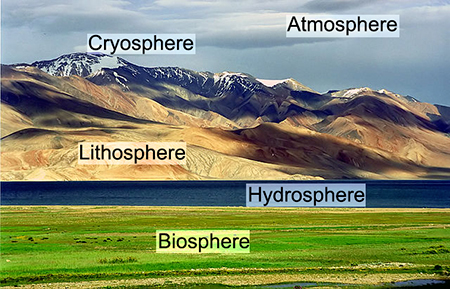Known in China as the Qinghai-Tibet Plateau or Qingzang Plateau, the Tibetan Plateau covers Qinghai Province and the Tibetan (or Xizang) Autonomous Region of China. Dubbed the Third Pole, the extended plateau region spans more than 5 million square kilometers, with an average elevation about 4000 meters above sea level.
The plateau serves as a “water tower” for more than 1.5 billion people.
The Third Pole has numerous glaciers topping great mountain ranges, including the Himalayas, Karakoram, Hengduan, Kunlun, and Qilian. The plateau contains the headwaters for major rivers in surrounding countries; hence, it serves as a “water tower” for more than 1.5 billion people.
The August 2016 International Workshop on Land Surface Multi-spheres Processes of Tibetan Plateau was held in Xining, China, the capital city of Qinghai Province, and was cochaired by Tandong Yao of the Institute of Tibetan Plateau Research (China) and Yongkang Xue of the University of California, Los Angeles. The workshop attracted more than 230 registered participants from 13 countries, including China, the United States, Japan, Nepal, the Netherlands, and India. Additionally, approximately 20 volunteers partially staffed the conference. The conference was designed to bridge knowledge gaps and foster broad international and interdisciplinary collaborations.

The workshop featured the first comprehensive exchange of quantitative studies under the Tibetan Plateau multisphere research framework, which encompasses the atmosphere, hydrosphere, cryosphere, biosphere, anthrosphere (a human-environment interaction system), and lithosphere. The workshop showcased quantitative studies on the plateau’s environment and climate and their interactions with other parts of the world. Attendees from different scientific disciplines communicated recent findings about how multisphere processes on the Tibetan Plateau influence regional and global climate, environment, and hydrology through dynamic, biophysical, and thermal mechanisms.
The workshop focused on seven main themes on the Tibetan Plateau:
- atmospheric and surface processes, energy and hydrological cycles, and their interactions with the systems of Asian monsoons and global climate
- in situ observations, proxy records, and remote sensing data for the quantitative analysis, model validation, and understanding of the Third Pole environment
- surface parameterizations and their applications to regional climate prediction and climate model validation
- aerosol-cloud-radiation interactions and their climate impacts
- ecosystem dynamics and anthropogenic impacts
- cryosphere change and its hydrological responses
- the paleoenvironment on the plateau
The workshop included two plenary sessions and nine parallel sessions of oral presentations, plus poster and summary sessions. All sessions covered major current Tibetan Plateau environment research topics, such as surface processes modeling, ecosystem changes, the paleoenvironment, water resources, and remote sensing.
Increasing multidisciplinary studies would help researchers better respond to expected environmental challenges such as rapid glacier melt and an accelerated water cycle.
Workshop presenters called for more multidisciplinary studies to help integrate field observations, modeling, and analysis; generate convenient data services for research; and accurately quantify uncertainties. Increasing multidisciplinary studies would help researchers better respond to the significant Tibetan Plateau environmental challenges expected in the coming decades, such as rapid glacier melt and an accelerated water cycle.
Seventeen organizations sponsored the workshop, including the American Geophysical Union and the Third Pole Environment. An international organization that facilitates Tibetan Plateau environment research, the Third Pole Environment was the main local organizer of the workshop.
More information can be found on the workshop’s two websites.
—Samuel Shen (email: [email protected]), San Diego State University, Calif.; also at Scripps Institution of Oceanography, La Jolla, Calif.; and Fan Zhang, Institute of Tibetan Plateau Studies, Chinese Academy of Sciences, Beijing
Citation:
Shen, S., F. Zhang (2017), Advancing a multisphere approach to Third Pole research, Eos, 98, https://doi.org/10.1029/2017EO072797. Published on 11 May 2017.
Text © 2017. The authors. CC BY 3.0
Except where otherwise noted, images are subject to copyright. Any reuse without express permission from the copyright owner is prohibited.

